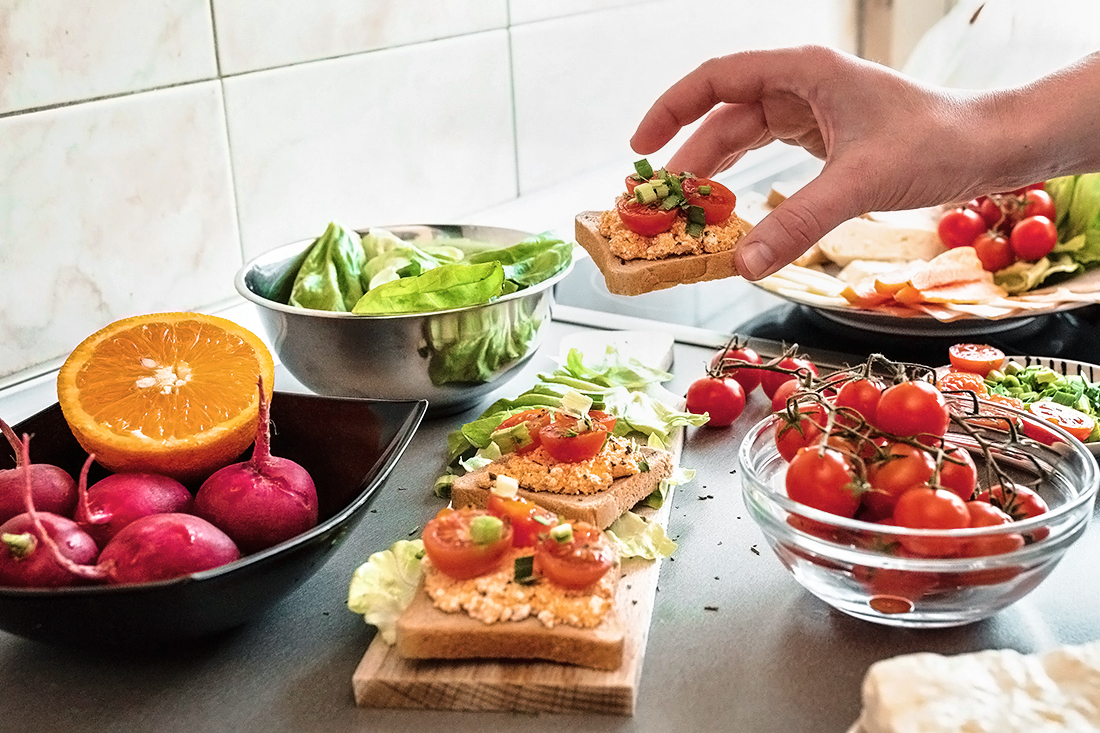
Snacks serve many purposes. For those with long days, specific nutrition needs, limited time to eat, or other reasons, snacks can be an important way to keep our body and our brain nourished and satisfied. But snacking can and should also provide us with a pleasurable experience, just like our meals. A snack is a component- just one part of an eating pattern, and (important message here) it does not mean you have “cheated” or are “bad” for enjoying something lovely and special. Remember, there is no perfect way of eating for everyone.
Here Are Some Basics to Consider:
- Eat a nutrient-rich diet that includes a variety of healthful foods.
- Become aware of carbohydrates in foods, especially if you are dosing meal/snack-time insulin.
- Space meals throughout the day in ways that work for you and your individual needs.
- Managing diabetes means creating a plan to keep your blood sugar levels in target range. Remember, there are as many as 42 factors that impact blood sugar levels – including stress, sleep issues, medications, movement, illness or infections, hydration, alcohol, genetics, and others. It’s not always about the food.
Additional Tips and Ideas for Supportive Snacking:
- Consider protein sources such as string cheese sticks, yogurt, cottage cheese, eggs, nuts, and nut butters.
- Add some fiber, which delays digestion and encourages satiety and blood sugar stability. Embrace fruits and vegetables. Include whole grain bread, rye crackers, oats, brown rice, and quinoa for some high fiber choices.
- Choose foods that are portable for convenience. For example, individual Greek yogurt containers, string cheese, nuts, hard-boiled eggs, and commercially available nutrition drinks designed for people with diabetes such as Glucerna. Glucerna’s mini treats and snack bars can also be used as a tasty and portable option to support nutrition needs.
- Plan to eat snacks just prior to the time of day when you get the hungriest or if there is a long gap between your meals. Many people find having some nourishment about every four hours during their waking hours helps keep hunger and blood sugar levels stable.
- Practice mindful eating. Experiment with minimizing distractions like computers, television, smartphones, driving, etc. Sit down while you eat and take the time to savor your snack (or meal). Try listening to music or eating outdoors instead of looking at screens.
- Enjoy your snack with water. Many of us forget to drink water throughout the day, but adding it to your snack can be a helpful reminder to increase your overall intake.
- Consider “activity snacks”. Sometimes we feel that exercise needs to be “all or nothing” such as an hour-long walk or gym time, but a quick 10–15-minute movement break like dancing to a favorite tune, sweeping a floor, a bit of gardening, or tossing a ball to your dog can also do wonders for energy level and blood sugar management (but this does not take the place of necessary nourishment).
Strict dieting and exercise commitments often fade, and in many cases, lead to more disappointment, guilt, and shame, as well as physical harm. This can lead to an increase in “emotional eating” (vs. eating for nourishment and pleasure) which can perpetuate a vicious cycle that can negatively impact diabetes management. Remember, this is about self-care and self-compassion, instead of self-control.
As a Registered Dietitian Nutritionist and Diabetes Health and Education Specialist, I’ve seen the sadness and mental and physical harm that comes from years of weight cycling, restricting, and diet fads. I’d like to help you honor your body, health, and optimize your quality of life with sustainable suggestions. Experiment with these kinder, gentler, and healthful ideas that you might want to consider starting any time you are ready.
About the Author:
Janice Baker, MBA, RDN, CDCES, CNSC, BC-ADM works with Palomar Health Medical Group in San Diego, California, and can be contacted for questions at Janice.Baker@PalomarHealthMedicalGroup.org
Partnership:
Abbott Nutrition is a partner of TCOYD.
Additional Resources:
How to Get More Brightly Colored Food into Your Diet (and Not Just M&M’s!)
5 Nutritional Tips on Aging with Diabetes
New Study Highlights People with Diabetes May Not Be Consuming Enough Protein
What Should My Blood Sugar Be after Eating a Meal?
Strike the Spike: Controlling Blood Sugars After Eating
Facebook Live: Heart-Healthy and Diabetes-Friendly Diets


I had a cortisone shot yesterday and my glucose level Went from 210 too 290. What do I do.zt 3:00 o’clock this morning it was 280. Please let me know what to do.
Well, first of all don’t panic…your numbers will come down. If you are on fast-acting insulin, ask your HCP how much to take. You can also drink lots of fluids and do moderate exercise.